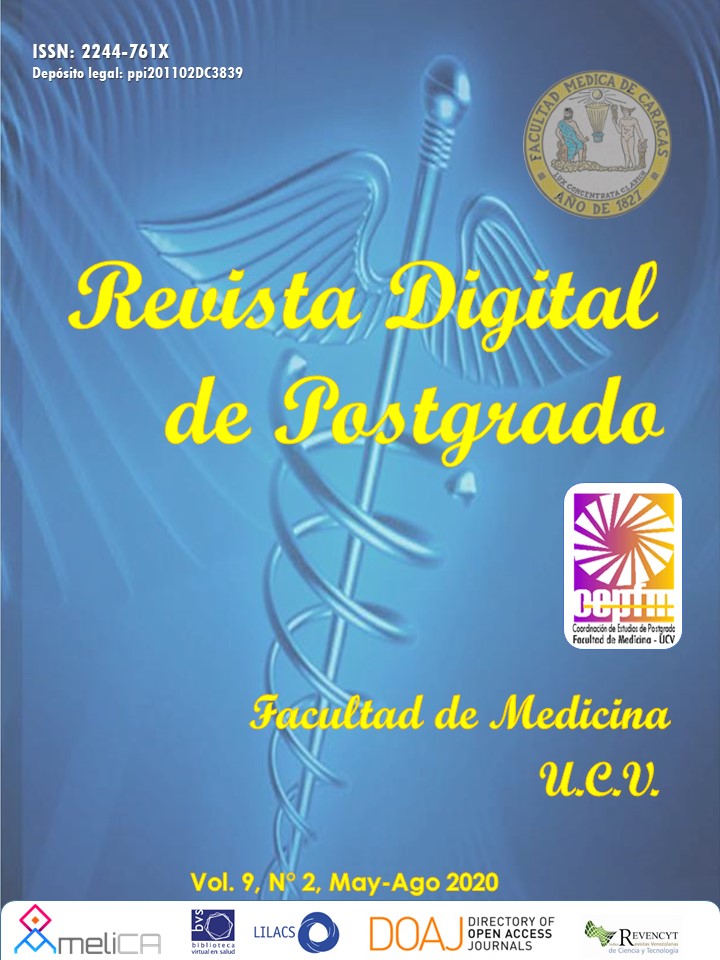Risk of developing type 2 diabetes according to LA FINDRISC and peripheral arterial disease
Keywords:
LA FINDRISC, Ankle-Brachial Index (ABI), Type 2 Diabetes Mellitus, peripheral arterial disease.Abstract
Introduction: Type 2 diabetes mellitus (DM2) represents a public health problem, due to its high incidence and prevalence in the world. One method to assess the risk of developing DM2 is the Latin American Finnish Diabetes Risk Score (LA FINDRISC) scale. DM2 is a risk factor for peripheral arterial disease (PAD) which can be diagnosed using the ankle-brachial index (ABI). Objective: to evaluate the presence and severity of peripheral arterial disease using ABI and to relate it to the risk of developing DM2 according to LA FINDRISC. Methods: descriptive, correlational, cross-sectional study. 134 people were evaluated, and capillary glycemia was measured to rule out diabetes. Subsequently, the LA FINDRISC and the ITB were held. Results: The LA FINDRISC score and impaired fasting blood glucose increased proportionally (R2 = 0.5). This relationship was not observed between LA FINDRISC and the ITB showed by the general population. However, when selecting patients with non-compressible vessels, a positive correlation (R2 = 0.36) appears between the two diagnostic instruments. Conclusion: FINDRISC and ITB are simple and valid non-invasive diagnostic instruments to detect the risk of developing DM2, and detect the presence and severity of peripheral arterial disease, respectively.Downloads
References
- Jaacks LM, Siegel KR, Gujral UP, Narayan KM. Type 2 diabetes: A 21st century epidemic. Best Pract Res Clin Endocrinol Metab. 2016; 30(3): 331‐343. doi:10.1016/j.beem.2016.05.003.
- Lindström J, Tuomilehto J. The diabetes risk score: a practical tool to predict type 2 diabetes risk. Diabetes Care. 2003; 26(3): 725-31. doi:10.2337/diacare.26.3.725
- Vera LA, Jaimes MO, Burgos I. Burgos RB. Prevalencia de la enfermedad arterial periférica en pacientes diabéticos tipo 2, aplicando el índice tobillo-brazo en el hospital “Seguro Social Universitario”. Rev Med La Paz, 2014; 20(1):12-17.
- American Diabetes Association. Introduction: Standards of Medical Care in Diabetes 2018. Diabetes Care 2018; 41(Suppl.1):S1–S2. doi:10.2337/dc18-SINT01.
- Aboyans V, Ricco JB, Bartelink ML, Björck M, Brodmann M, Cohnert T, et al. Guía ECS 2017 sobre el diagnóstico y tratamiento de la enfermedad arterial periférica, desarrollada en colaboración con la European Society for Vascular Surgery (ESVS). Rev Esp Cardiol. 2018; 71(2): 111.e1-111.e69. doi: 10.1016/j.recesp.2017.12.015.
How to Cite
Issue
Section
License
Usted es libre de:
- Compartir — copiar y redistribuir el material en cualquier medio o formato
- Adaptar — remezclar, transformar y construir a partir del material
- para cualquier propósito, incluso comercialmente.
Bajo los siguientes términos:
-
Atribución — Usted debe dar crédito de manera adecuada, brindar un enlace a la licencia, e indicar si se han realizado cambios. Puede hacerlo en cualquier forma razonable, pero no de forma tal que sugiera que usted o su uso tienen el apoyo de la licenciante.
- No hay restricciones adicionales — No puede aplicar términos legales ni medidas tecnológicas que restrinjan legalmente a otras a hacer cualquier uso permitido por la licencia.











